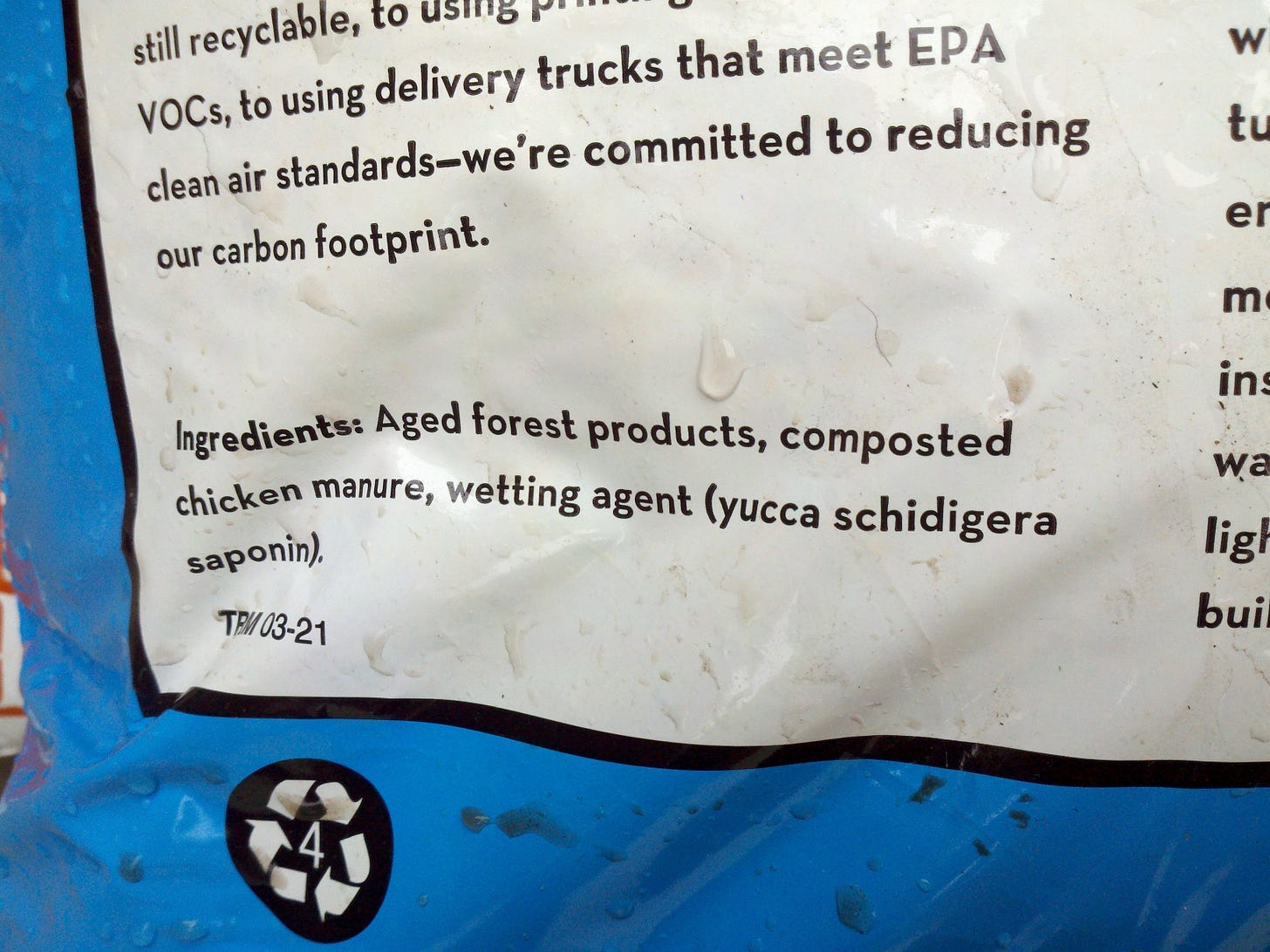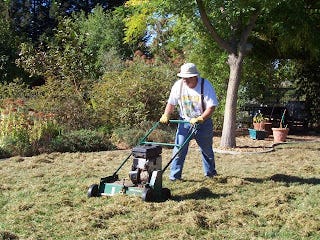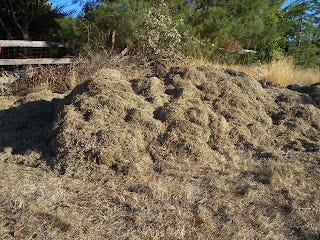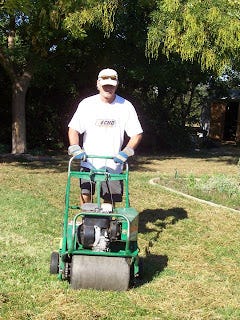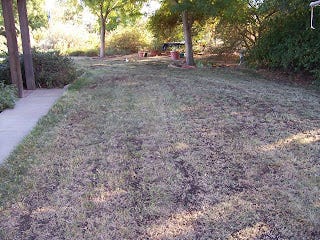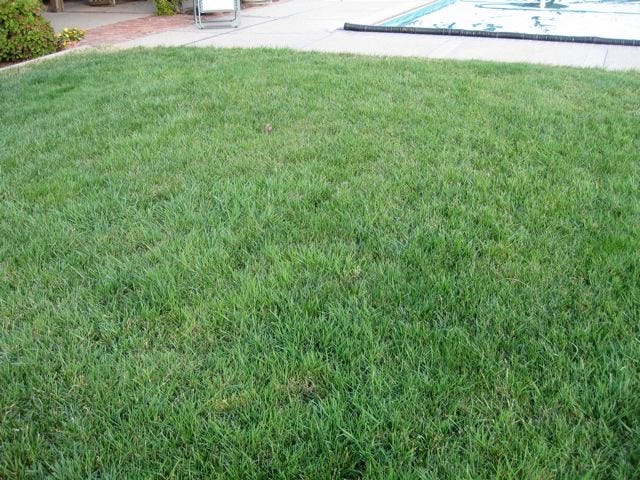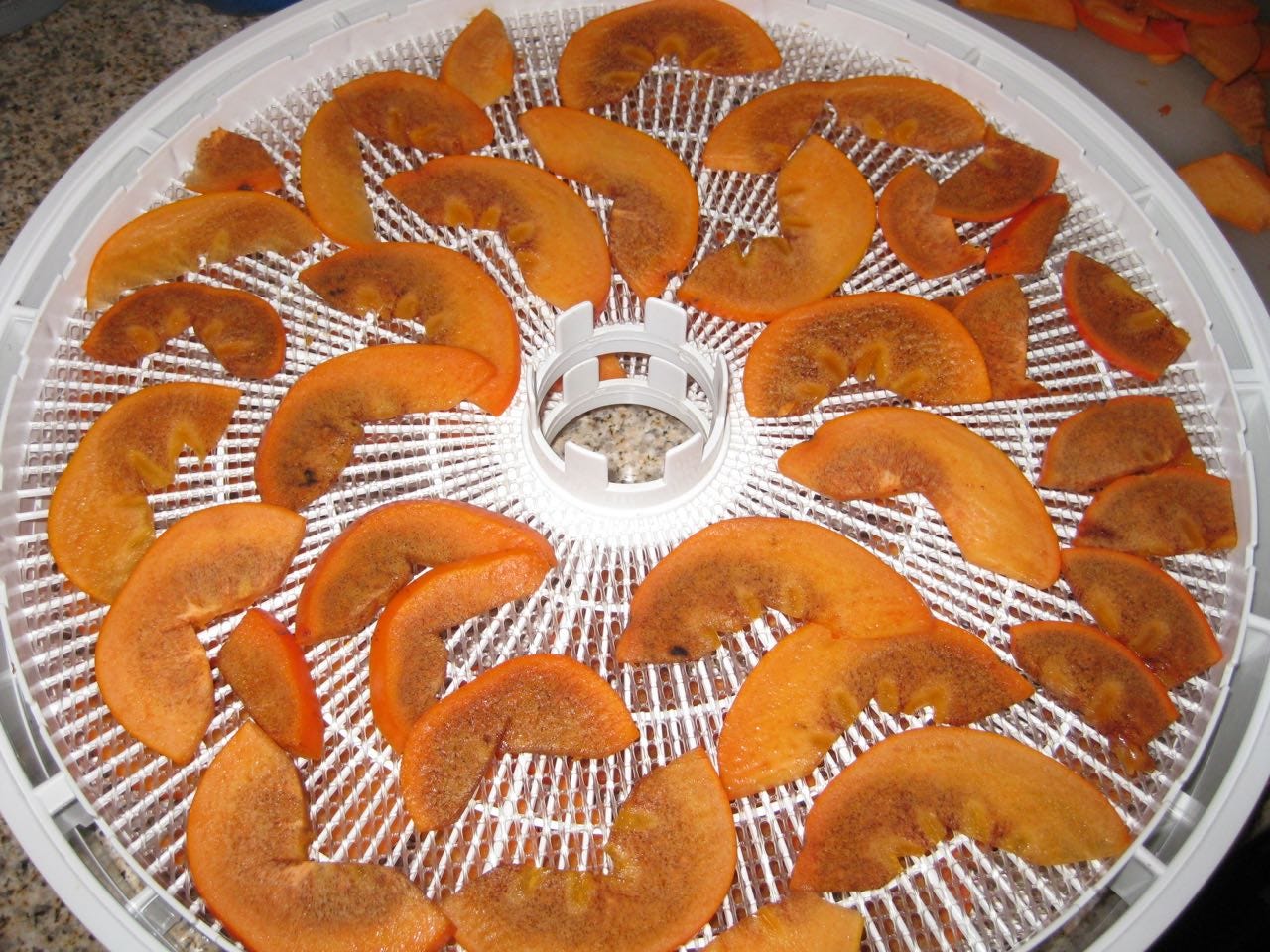All About Persimmons. Lawn Reseeding Tips.
A deeper dive into Episode 148 of the Garden Basics with Farmer Fred podcast.
I am always learning something new about horticulture whenever our favorite retired college horticulture professor, Debbie Flower, joins us on the podcast. In Episode 148, during our discussion of reseeding a lawn, we learned a new word:
Yes, Hummocky. Sort of like this. Lumpy.
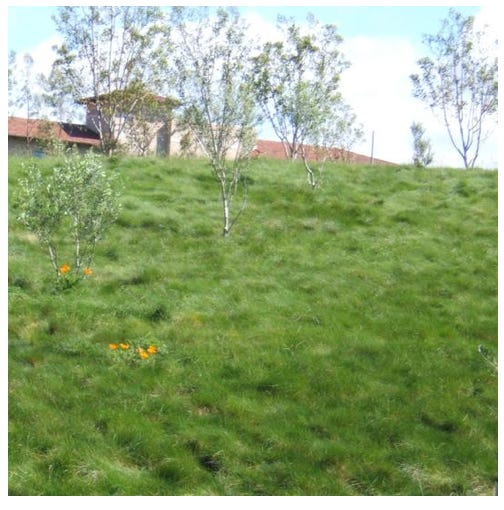
During our discussion of all that is entailed when simply reseeding a lawn in early to mid fall (in USDA Zone 9) or in spring (everywhere), we pointed out many of the processes to be done to not only make your lawn look great, but also to improve the soil, including using the right lawn seed, a dethatcher, an aerator, seed spreaders, compost spreaders, a heavy duty roller and some sort of starter fertilizer.
During our chat, I mentioned one brand of a top dressing for a newly seeded (or reseeded) lawn, Top Coat. I said I didn’t know what the ingredients were, but if you give me 10 minutes, I could find out. My 10 minutes are up:
Turns out, Debbie had mentioned that she used well-aged chicken manure for her top dressing…so, all is good.
Here’s a deeper dive into tips for reseeding your lawn, adapted from the Farmer Fred Rant Blog Page:
In drought-stricken California, as in many other locales in the West and Southwest, watering a lawn every day is no longer an option. Ordinances throughout California mandate a maximum of two days a week for landscape irrigation (soon to be one day).
And the response by some homeowners? "If I don't water my lawn every day, it turns brown!" I hear this far too often from listeners on my garden radio shows.
There are a lot of possible culprits for this scenario: compacted or poor soil, slow drainage, the wrong turf type for the area, sloping lawns, uneven coverage by sprinklers and more.
The biggest culprit in lawn problems? Watering a lawn every day. Daily, light irrigations causes lawn roots to remain near the surface, where they are more susceptible to damage from heat, cold, animals, disease, etc.
And those lawn roots may not be getting much water, because of thatch buildup.
According to the UC Guide to Healthy Lawns, thatch is the layer of living and dead stems, roots, stolons, and rhizomes between the green blades of grass and the soil surface. A thin layer of thatch (less than 1/2 inch thick) can be beneficial to the lawn because it helps to limit weed germination, reduce water evaporation, and protect from frost damage. However, thick thatch layers can prevent water, air, and nutrients from penetrating the soil, causing reduced root growth and increased potential for drought stress. Thatch also favors fungal growth and can harbor insect pests. Some turfgrass species, such as bermudagrass, bentgrass, and Kentucky bluegrass, have creeping growth habits and rapidly build thick thatch layers. But even the popular fescue varieties of lawn can build up a thick layer of thatch, even though the grass is green on the surface.
If you haven't dethatched your lawn in three years or more, September through mid-October is the time to not only dethatch, but to also aerate, fertilize and overseed your lawn.
If more than 40% of your lawn is in really bad shape, then consider a complete lawn renovation in September or early October here in the mild winter areas of California. In other parts of the country, spring is the best time for this makeover. A complete lawn renovation involves removing all the existing turf, improving the soil and reconfiguring the sprinkler system to better cover the entire area, as well as choosing the right turf type for your area. Directions for a complete renovation can be found here.
A partial lawn renovation involves uprooting thatch, aerating the soil, overseeding the lawn area and applying a thin layer mulch to maintain a healthy lawn throughout the coming year.
The first step is to cut your lawn as short as possible. Then, water your lawn thoroughly to soften the soil. Wait a day or two. Then bring on the necessary components: a dethatcher, aerator, starter fertilizer, compost for mulch, lawn seed, drinks and snacks. After all, if you've worked in the yard all day, who'll have the energy to run to the store for refreshments?
The dethatcher can be as simple as an iron rake or as complex as a power dethatcher or vertical mower, available at rental yards. Thatch - layers of dead grass - impede the movement of water and fertilizers to the root zone of a lawn and should be removed every two or three years.
During the dethatching process, you may be in for a rude awakening. See that pile of thatch? It's about two cubic yards. That's what we removed from about 4000 square feet of what looked to be an otherwise healthy lawn. You can't see thatch when it's just below the lawn's surface!
After dethatching, remove the dead grass and then aerate the lawn area. An aerator, a device with sharp, hollow tubes, removes soil cores that are three to four inches deep. Aeration relieves soil compaction, allowing air, water and fertilizer to pass more freely through the soil, stimulating root growth. Hand aerators are available, but rented roller or power-driven aerifiers do the job more quickly and effectively, albeit more expensively.
Then, spread starter fertilizer and a lawn seed that closely matches your existing grass over the area. However, for Bermudagrass lawns, overseed with an annual or perennial ryegrass; this will keep your lawn green during the winter and spring while the Bermuda grass is brown and dormant.
After overseeding, press the seed into the ground with a water-filled roller, or rake the seed lightly to make sure it is in contact with the soil. Finish up by spreading a thin layer of compost over the entire area.
Keep the reseeded lawn area moist; the new seeds will sprout in seven to ten days. This is the ONLY time you need to water a lawn every day, keeping the seedbed evenly moist until the grass is up and growing. Then, set your sprinklers to come on for a period of time that's appropriate for the weather: two or three times a week during the hottest months; once a week during the cooler months when it doesn't rain. And turn off the system entirely during the rainy season.
After dethatching, aerating and overseeding, your lawn will look absolutely terrible. Do not fear.
By Thanksgiving, you will have the greenest lawn on the block!
No, We Won’t forget the American Persimmon
In Episode 148 of Garden Basics, Phil Pursel of Dave Wilson Nursery discussed tips for growing a fall favorite of a fruit tree for the West, South and along the south and central Atlantic Seaboard states: Japanese persimmons (Diosypros kaki). Bottom line: Fuyu persimmons are great! Give a listen to learn about more tasty varieties. My favorite way to enjoy Fuyu persimmons? Dried!
However, the American persimmon is more widely grown, a native of the East, South and Midwest of the United States. The large size of the tree and the astringent fruit (mouth puckering, to say the least) make this persimmon an acquired taste. Here are more details about the American persimmon (Diospyros virginiana) from the USDA:
Common persimmon is found from southern Connecticut and Long Island to southern Florida; westward through central Pennsylvania, southern Ohio, southern Indiana, and central Illinois to southeast Iowa; and south through eastern Kansas and Oklahoma to the Valley of the Colorado River in Texas. It does not grow, however, in the main range of the Appalachian Mountains, nor in much of the oak-hickory forest type on the Allegheny Plateau. Its best development is in the rich bottom lands of the Mississippi River and its tributaries and in coastal river valleys (9). It is exceedingly common in the South Atlantic and Gulf States, often covering abandoned fields with a shrubby growth, and springing up by the sides of roads and fences. It is often the first tree species to start growth on abandoned and denuded cropland. It is well adapted to an environment of high insolation and low water supply.
The inconspicuous flowers bloom from March to June within its botanical range and from April through May in areas where it grows best. Staminate flowers are in two- or three-flowered cymes, tubular, 8 to 13 mm (0.3 to 0.5 in) long, and greenish yellow.
Pistillate flowers are solitary, sessile or shortpeduncled, about 1.9 cm (0.75 in) long. The corolla is fragrant with 4 or 5 greenish yellow, thick recurved lobes.
Common persimmon is dioecious; the staminate and pistillate flowers are borne on separate trees on shoots of the current year, when the leaves are more than half grown.
The fruit is a persistent spherical berry 1.9 to 5.1 cm (0.8 to 2.0 in) in diameter. It ripens from September to November or occasionally a little earlier. When mature it is yellow to orange or dark red in color, often with a glaucous bloom. Each berry usually contains one to eight flat, brown seeds about 13 mm (0.5 in) long but is sometimes seedless. Fruits fall from September to late winter.
The optimum fruit-bearing age is 25 to 50 years, but 10-year-old trees sometimes bear fruit. Good crops are borne about every 2 years under normal conditions. About 45 kg (100 lb) of fruit yields 4.5 to 13.6 kg (10 to 30 lb) of clean seed, with an average of 2,640 seeds per kg (1,200 seeds per lb). The seed is disseminated by birds and animals that feed on the fruits, and, to some extent, by overflow water in low bottom lands (9). The seeds remain dormant during winter and germinate in April or May, after about a month of soil temperatures above 15° C (60° F).
Persimmon is easily raised from seed, and if planting is to be done with seeds, they should be cleaned and spread out for drying for a day or two and then stratified under moist conditions for 2 to 3 months at 1° to 4° C (33° to 40° F). They should be soaked 2 to 3 days before planting. Seeds lose their viability through extremes of heat, cold, or drying. They should be planted in spring or fall in shallow drills in light soils with plenty of humus and covered to a depth of about 13 min (0.5 in).
No insects or animals are known to damage flowers or fruit seriously. Late freeze can damage the flowers and cause premature fruit drop.
Persimmon is sometimes planted for its edible fruit. Dried fruit is added to baked goods and occasionally is fermented with hops, cornmeal, or wheat bran into a sort of beer. The dried, roasted, ground seeds have been used as a substitute for coffee.
Several cultivars are available with improved fruit size and quality. The fruit is eaten by many species of song birds, also by the skunk, raccoon, opossum, gray and fox squirrels, white-tailed deer, wild turkeys, bobwhite, crows, rabbits, hogs, and cattle. It may, however, cause sickness in livestock. Deer browse readily on persimmon sprouts, but cattle graze them only lightly.
Persimmon is valued as an ornamental because of its hardiness, adaptability to a wide range of soils and climates, its lustrous leaves, its abundant crop of fruits, and its immunity from disease and insects. It has been introduced into Europe.
The tree is suitable for erosion control on deeper soils because of its deep root system, but this same characteristic makes it difficult to plant.
American Persimmon is considered a woody weed in unimproved pastures, and it prevents many areas from being grazed effectively.
Persimmon flowers are useful in the production of honey.
Thanks for Subscribing and Spreading the Word About the Garden Basics with Farmer Fred newsletter, I appreciate your support.
And thank you for listening to the Garden Basics with Farmer Fred podcast! It’s available wherever you get your podcasts. Please share it with your garden friends.
As an Amazon Associate, I earn from qualifying purchases from some of the underlined links in the newsletter. This is how I am trying to keep this a free newsletter. And as long as you buy whatever you want from Amazon using any of those links to get into the Amazon site, I get a few pennies. Thank you.



